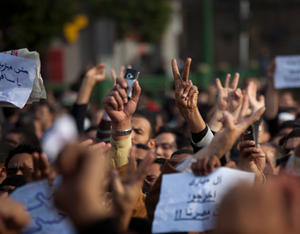Crisis in EgyptDisaffected youth, stagnation, poverty threaten Mideast regimes
In six Arab-Muslim states in the Middle East, six — Egypt, Jordan, Morocco, Oman, Saudi Arabia, and Yemen — more than 50 percent of the citizenry are under the age of 25; in other six states — Bahrain, Kuwait, Lebanon, Qatar, Tunisia, and the United Arab Emirates — the “under 25s” make up between 35 to 47 percent of the population; in Yemen, some 75 percent of the population is under 30, and the poverty rate exceeds 45 percent; in Egypt, some 66 percent of the population is under 30, while fully half the country’s 80 million citizens lives on less than $2 per day; since 1980, the Arab world has experienced the highest rate of [population] growth of any region in the world; during the same period, the Arab economies have been sputtering, creating far too few jobs

Egyptian youth has led the charge to unseat Mubarak // Source: tdbimg.com
The wave of street protests and government collapses spreading through the Arab world over the last month prove at least one thing: the argument that tensions in the Middle East would subside if only Israel withdrew from the occupied territories and reverted to its pre-Six Day War borders — an argument routinely repeated by successive generations of Arab leaders, and which has been uncritically accepted by many in the West, is false.
This does not mean that Israel should not end its occupation of Palestinian lands — and even, more importantly, of the Palestinian people — because Israel most certainly should, but it does mean that the grievances voiced by the demonstrators, and the responses from besieged Arab governments, have little if anything to do with the Israeli-Palestinian conflict.
Rather, analysts note that the underlying tensions are the result of the repressive nature of Arab and Muslim governments and the accompanying lack of economic opportunities.
Fox News reports that compounding the problem for Mideast despots — both those directly affected by the current wave of protests, and those eyeing it nervously from within their well-guarded palaces — are the raw numbers, the demographics, underlying the phenomenon. The tyrants’ antagonists are not conventional armies or coup plotters but literate and disaffected young people, more of them than ever before, armed with access to instant, global communications in the form of social networking media like Twitter, Facebook, MySpace, and the Internet.
This does not mean the if the literate and disaffected young people succeed in toppling the regime in Egypt or in other countries, they — the literate and disaffected young people and the political leaders they would prefer — would end up ruling the country. In Iran thirty years ago, the young and disaffected anti-Shah protesters eventually realized, when it was too late, that they were merely running interference for the ayatollahs. This may well be the case in Egypt if the protesters succeed not only in removing Hosni Mubarak from power, but also the military ruling structure which Gamal Abed el Nasser established in Egypt in 1952.
Fox News notes that of twelve selected Arab-Muslim states in the Middle East, six of them — Egypt, Jordan, Morocco, Oman, Saudi Arabia, and Yemen — house populations where more than 50 percent of the citizenry are under the age of 25. For the other six — Bahrain, Kuwait, Lebanon, Qatar, Tunisia, and the United Arab Emirates —
